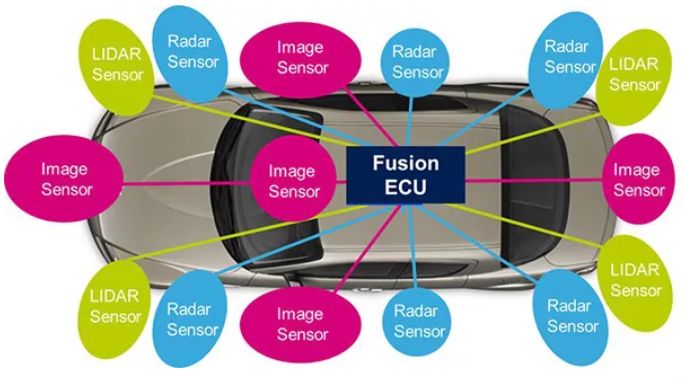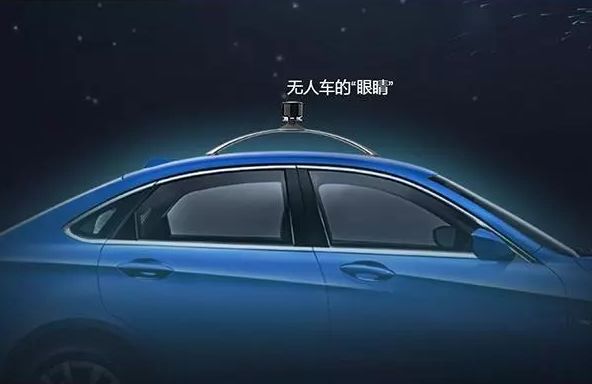If you want to realize the fully automatic driving function of SAE L4/L5 on the model of the year 2021/2022, it is necessary to apply multiple sensor redundancy systems. Today's semi-autonomous driving systems use various numbers and designs of radar and camera systems. The development of a laser detection and ranging system with high performance and reasonable price, capable of detecting information within a radius of 300 meters, is still in the pre-research stage. Most automakers believe that the three sensor systems of camera, radar and lidar are indispensable if they want to realize fully automatic driving.

At present, ultrasonic radar, millimeter-wave radar and multi-camera systems have been applied in high-end cars. With the development of intelligent driving, environmental perception technology will develop rapidly and further exert synergy. Although sensors are only part of autonomous vehicles, the market prospects are very broad. Therefore, relevant agencies predict that the global market for automotive cameras, millimeter wave radars and night vision systems will enter a period of rapid growth by 2020. The insight of camera smart driving
The vehicle-mounted camera is the basis for many early warning and recognition ADAS functions. Among the many ADAS functions, the visual image processing system is more basic and more intuitive for the driver, and the camera is the basis of the visual image processing system, so the on-board camera is essential for intelligent driving.
Lane Departure Warning (LDW), Forward Collision Warning (FCW), Traffic Sign Recognition (TSR), Lane Keeping Assist (LKA), Pedestrian Collision Warning (PCW), Panoramic Parking (SVP), Driver Fatigue Warning and many other functions All can be realized by the camera, and some functions can even be realized by the camera.
ADAS functions that the camera can realize
The price of car cameras continues to fall, and multiple cameras on bicycles will become a trend in the future. Compared with sensors such as vehicle-mounted radars, the price is lower, and it is easy to popularize and apply. The hardware system of Tesla Autopilot 2.0 contains 8 cameras. In the future, bicycles with multiple cameras will become a trend.
According to the requirements of different ADAS functions, the installation position of the camera is not the same. According to the different installation positions of the camera, it can be divided into four parts: front view, side view, rear view and built-in. To realize the full set of ADAS functions in the future, a bicycle needs to be equipped with at least 5 cameras. According to the estimates of the Advanced Industrial Research Institute (GGII), with the increase in the penetration rate of ADAS, the market size of cameras will increase from 2 billion yuan in 2016 to 5.8 billion yuan in 2020, with a compound annual growth rate of 30%.
The price of car cameras continues to fall
The front-view camera is used the most frequently, and a single camera can realize multiple functions. Through algorithm development and optimization, a single front-view camera can achieve multiple functions, such as driving record, lane departure warning, forward collision warning, pedestrian recognition, etc. In the future, it is also expected to realize more ADAS functions through algorithm integration.
The front-view camera is generally a wide-angle lens, which is installed at a higher position on the rearview mirror of the car or on the front windshield to achieve a longer effective distance.

Side-view cameras instead of rear-view mirrors will become a trend. Due to the limited range of the rearview mirror, when another car behind the diagonally behind is outside this range, it is "stealth". The part outside this range is called a blind spot. Because of the existence of blind spots, the probability of traffic accidents is greatly increased. The installation of side-view cameras on both sides of the vehicle can basically cover the blind area. When a vehicle enters the blind area, it will automatically remind the driver to pay attention. This is the blind area monitoring system.
There is also a new trend that uses a side-view wide-angle camera to replace the rear-view mirror, which can reduce wind resistance, and at the same time obtain a larger and wider viewing angle, to avoid accidents in dangerous blind spots. BMW i8 Mirrorless concept car Just use this design.
Car rearview mirror blind spot
The panoramic parking system calls multiple cameras around the body to help parking open the "God's perspective". The panoramic parking system uses multiple ultra-wide-angle cameras installed around the vehicle body to collect images around the vehicle at the same time. After the image processing unit is corrected and spliced, a panoramic top view of the vehicle is formed, which is transmitted to the display device of the center console in real time on.
When sitting in the car, the driver can intuitively see the position of the vehicle and the obstacles in the weekly report from the "God's perspective", and calmly manipulate the parking into position or pass through complex roads, effectively reducing the occurrence of scratches, collisions and other accidents.
Image stitching technology of panoramic parking system
Car cameras are widely used and relatively inexpensive. They are the most basic and common sensors. The market space in the future will exceed RMB 10 billion.
Cameras are essential for multiple ADAS functions, and the unit price is expected to continue to fall in the future, which will drive the rapid growth of the car camera market. According to estimates, global car camera shipments will increase from 28 million in 2014 to 83 million in 2020, a compound growth rate of 20%.
Based on this estimate, the global automotive camera market will grow from RMB 6.2 billion in 2015 to RMB 13.3 billion in 2020, with a compound annual growth rate of 16%. The consumption area is mainly in the Americas, Europe, Asia Pacific and other places, and the Asia Pacific region will become the fastest growing market.
2020 domestic car camera market demand calculation
The camera industry chain mainly consists of lens groups, CMOS (Complementary Metal-Oxide Semiconductor), DSP (Digital Signal Process), and module packaging.
In recent years, the rapid growth of smart phones has driven the vigorous development of the camera market, but the growth rate of smart phones has slowed since 2014, and the future growth rate of mobile phone cameras will also slow down. With the rise of the car camera market, the production capacity of all links in the mobile phone camera industry chain will be transferred to the car camera industry. It is expected that the CMOS, lens, module packaging and other industrial chain links will continue to maintain high growth in the future.
An essential sensor for radar ranging and speed measurement
Radar irradiates the target object by emitting sound waves or electromagnetic waves and receives its echo, thereby obtaining the target object's distance, distance change rate (radial speed), size, orientation and other information. Radar was first used in the military, and then gradually civilian use.
With the development trend of automobile intelligence, radar began to appear in automobiles, mainly used for ranging, speed measurement and other functions. Automotive radars can be divided into ultrasonic radars, millimeter wave radars, lidars, etc. Different radars have different principles and have their own advantages in performance and can be used to achieve different functions.

Basic architecture of radar sensor (only for raw data collection)
(1) Ultrasonic radar
Ultrasonic radar uses the ultrasonic generator in the sensor to generate 40KHz ultrasonic waves, and then the receiving probe receives the ultrasonic waves reflected by the obstacle, and calculates the distance to the obstacle according to the time difference of the ultrasonic reflection and reception. Ultrasonic radar has low cost, high accuracy of detection distance, and is not affected by light conditions, so it is often used in parking systems.
The automatic parking function is inseparable from the ultrasonic radar. BMW’s latest i-series and 7-series already support the use of the car key to remotely control the car’s automatic parking. During the operation, the user only needs to give forward or backward instructions, and the car will continue to use ultrasonic sensors to detect parking spaces and obstacles and automatically operate the steering wheel. And brake to realize automatic parking.
(2) Millimeter wave radar: ADAS core sensor
Millimeter wave refers to electromagnetic waves with a wavelength between 1mm and 10mm. When converted into frequency, the frequency of millimeter wave is between 30GHz and 300GHz. The wavelength of millimeter wave is between centimeter wave and light wave, so millimeter wave has the advantages of microwave guidance and photoelectric guidance.
Millimeter-wave radars are widely used in missile guidance, target surveillance and interception, artillery fire control and tracking, high-speed communications, satellite remote sensing and other fields. In recent years, with the improvement of millimeter-wave radar technology and the decrease in cost, millimeter-wave radar has begun to be used in the automotive field.
The key technologies of millimeter wave radar are mainly controlled by foreign electronics companies. The millimeter wave radar system mainly includes an antenna, a transceiver module, and a signal processing module. The MMIC (Monolithic Microwave Integrated Circuit) chip and the antenna PCB board (Printed Circuit Board) are the hardware core of the millimeter wave radar.
At present, the key technologies of millimeter-wave radar are mainly monopolized by Bosch, Continental, Denso, Autoliv and other component giants, especially the 77GHz product technology is only controlled by a few companies such as Bosch, Continental, Denso, and Delphi.
Lidar is powerful and cost reduction can be expected
Lidar is a high-precision radar technology that converts military to civilian. At the beginning, the application of lidar was mainly in the military field, which attracted great attention from the military departments of various countries. Compared with ordinary radar, lidar can provide high-resolution radiation intensity geometric images, distance images, and speed images. In the civilian field, lidar is also widely used because of its superior performance in ranging, speed measurement, three-dimensional modeling and other fields.

Lidar has excellent performance and is the best technical route for unmanned driving. Compared with other autonomous driving sensors, Lidar has very superior performance:
1) High resolution. Lidar can obtain extremely high angle, distance and speed resolution. Generally, the angular resolution of lidar is not less than 0.1mard, which means it can distinguish two targets 0.3m apart at a distance of 3km, and can track multiple targets at the same time; the range resolution can reach 0.1m; the speed resolution can reach 10m /s or less. Such high range and speed resolution means that lidar can use Doppler imaging technology to obtain very clear images.
2) High precision. The laser spreads in a straight line, has good directivity, a very narrow beam, and very low dispersion, so the laser radar has a high accuracy.
3) Strong anti-active interference ability. Unlike microwave and millimeter-wave radars that are easily affected by electromagnetic waves that exist in nature, there are not many signal sources that can interfere with lidar in nature, so lidar has a strong ability to resist active interference.
Lidar can be divided into one-dimensional laser radar, two-dimensional laser radar, three-dimensional laser scanner, three-dimensional laser radar and so on. One-dimensional lidar is mainly used for distance measurement and speed measurement, two-dimensional lidar is mainly used for contour measurement, object recognition, area monitoring, etc., and three-dimensional lidar can realize real-time three-dimensional space modeling.
Vehicle-mounted 3D lidar is generally installed on the roof of the car and can be rotated at high speed to obtain point cloud data in the surrounding space, so as to draw a real-time 3D spatial map around the vehicle; at the same time, the lidar can also measure other surrounding vehicles in three directions The distance, speed, acceleration, angular velocity and other information of the vehicle are combined with GPS map to calculate the position of the vehicle. These huge and rich data information are transmitted to the ECU for analysis and processing, so that the vehicle can quickly make judgments.

WENZHOU TENGCAI ELECTRIC CO.,LTD , https://www.tengcaielectric.com
